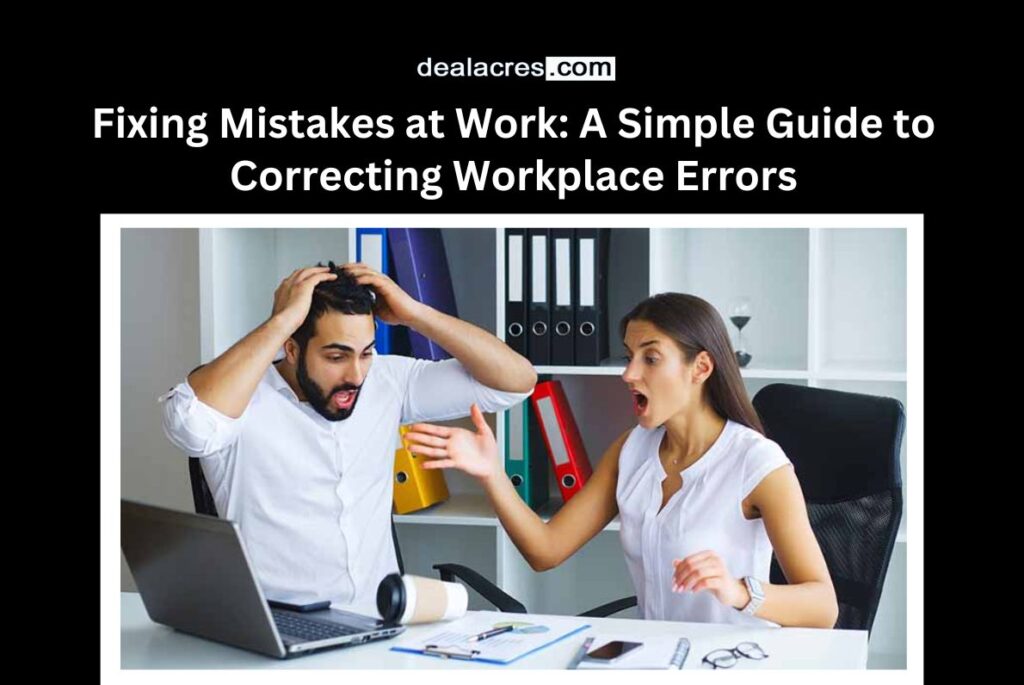Introduction:
At work, we all make mistakes from time to time – it’s just part of the job! Whether it’s a tiny slip-up or a bigger mess, what really matters is how we deal with these slip-ups. This guide is here to help you figure out easy and effective ways to fix mistakes at work, make the workplace a happier space, and help you become better at your job. So, let’s dive into some simple tips that will not only make things right but also help you become a pro at handling hiccups in your work journey.
Section 1: Acknowledge the Mistake
The first step in correcting any mistake is acknowledging it. Don’t try to hide or ignore the error; instead, take responsibility for it. This shows maturity and accountability. Understand that everyone makes mistakes, and it’s a natural part of learning and growing in your career.

Section 2: Stay Calm and Focused
When you realize you’ve made a mistake, it’s easy to panic or feel overwhelmed. However, it’s crucial to stay calm and focused. Panicking can lead to more errors and hinder your ability to fix the initial mistake. Take a deep breath, gather your thoughts, and approach the situation with a clear mind.
Section 3: Analyze the Impact
To effectively correct a mistake, you must understand its impact on the work environment, your colleagues, and the overall goals of the organization. Assess the consequences and prioritize addressing those that have the most significant impact first. This analytical approach helps you develop a strategic plan for correction.
Section 4: Communicate Transparently
Effective communication is key in correcting workplace errors. Be transparent about the mistake, explaining what happened, why it occurred, and what steps you’re taking to rectify it. Open communication builds trust among colleagues and superiors and shows that you’re committed to resolving the issue.

Section 5: Collaborate with Colleagues
Don’t hesitate to seek input from your colleagues. They may offer valuable perspectives and solutions that you might not have considered. Collaborative problem-solving fosters a sense of teamwork and unity in the workplace. Together, you can find effective solutions and prevent similar mistakes in the future.
Section 6: Learn from the Mistake
Viewing mistakes as learning opportunities is essential for personal and professional growth. Reflect on the error, analyze the factors that contributed to it, and develop a plan to avoid similar situations in the future. Continuous improvement is a key aspect of any successful career.
Section 7: Implement Corrective Actions
Once you’ve identified the best course of action, implement corrective measures promptly. Whether it involves updating a report, apologizing to a colleague, or revising a project plan, take decisive steps to rectify the mistake. Proactive correction demonstrates your commitment to accountability and improvement.
Section 8: Seek Guidance from Supervisors
If the mistake is significant or you’re unsure about the best approach to correction, seek guidance from your supervisors. They can provide valuable insights, offer support, and help you navigate the process. Don’t hesitate to ask for assistance; it’s a sign of responsibility and a commitment to delivering high-quality work.

Section 9: Monitor and Evaluate
After implementing corrective actions, monitor the situation to ensure the mistake is fully rectified. Evaluate the effectiveness of the measures taken and make adjustments if necessary. This ongoing assessment ensures that the workplace continues to function smoothly and that lessons learned are applied in future tasks.
Section 10: Conclusion
Fixing mistakes at work is something everyone can get better at. When you realize you’ve made a mistake, admit it and try not to get too upset. Stay calm and talk openly about what happened with your team. Working together with your colleagues is essential – they might have good ideas to help fix things.
Learning from your mistakes is a big part of getting better at your job. Don’t just focus on fixing the problem right away; think about how you can avoid making the same mistake again. When you do this, you’re not just solving the current issue but also making your workplace better for everyone.
Remember, it’s okay to make mistakes. Look at them as chances to learn and become even better at what you do. By doing this, you’ll grow into a more resilient and successful professional. So, next time you make a mistake, take a deep breath, fix it, and see it as a step towards becoming the best version of yourself at work.




